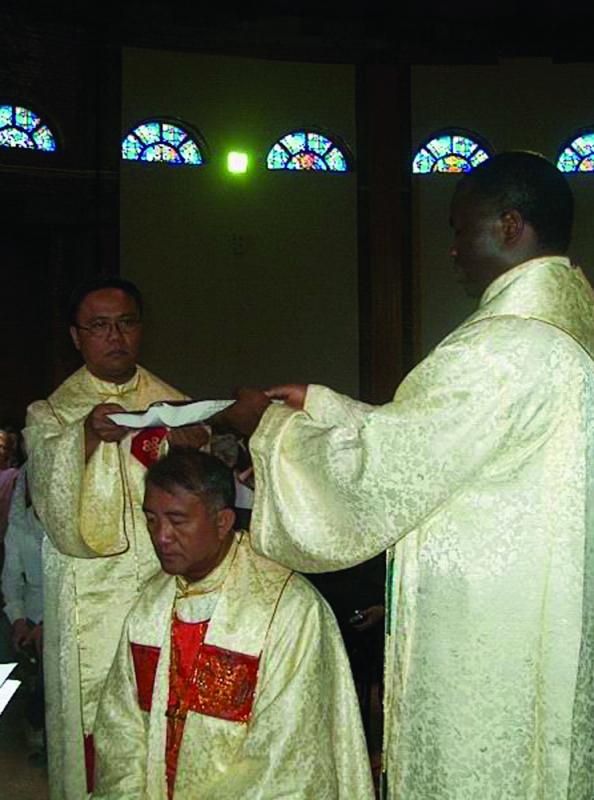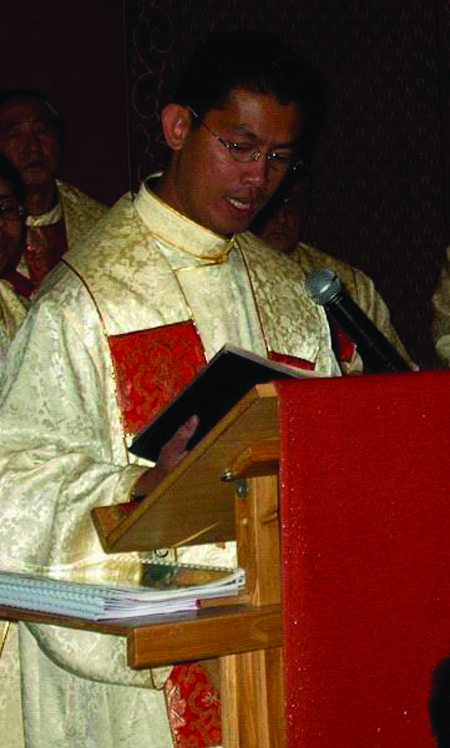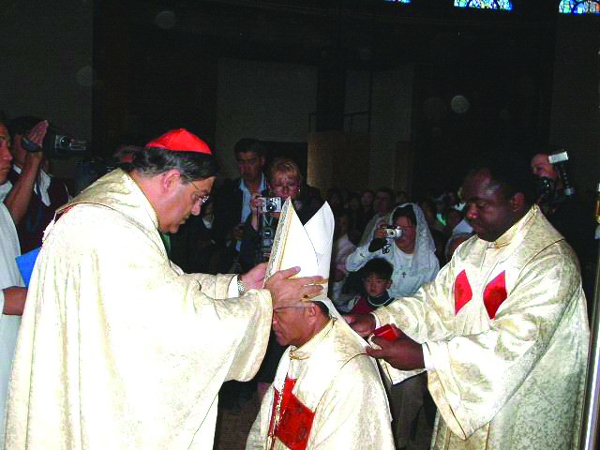Three Historic Days For The Church In Mongolia
By Serge Patrick Mondomobe CICM

The first Catholic mission in Mongolia in modern times was opened in 1992. The leader of the first three missionaries, Father Wenceslao S. Padilla CICM, from La Union, became the first ever bishop in Mongolia on August 29, ordained in the newly built cathedral in Ulaanbaatar, the Mongolian capital, that was consecrated the following day. Father Patrick, the author, is from Cameroon.
A bishop needs a cathedral but you need to have a bishop to bless a cathedral. The Church in Mongolia had neither. The Vatican decided a bishop should come first, with a cathedral the following day. Jan Pieter Cardinal Schotte CICM, the Belgian Secretary of the Roman Curia, pointed out a few days before the ordination of his Filipino confrere, Monsignor Wenceslao Padilla CICM, as the first ever bishop in Mongolia that it would be a miracle if the church were ready for that event. The cardinal didn’t seem reassured by the words of the architect that it would. The bishop-elect remained calm.
August 29 2003: Ordination of the first Bishop of Mongolia

The Book of Gospels being held over the head of the new bishop
Crescenzio Cardinal Sepe, the Italian Prefect of the Congregation for the Evangelization of Peoples, ordained Msgr Wenceslao Padilla CICM as bishop on Friday 29 August 2003, the Feast of the Beheading of St John the Baptist. It was also the 97th birth anniversary of Constancio Padilla, a faithful catechist for many years with the CICM missionaries in La Union and the late father of the new bishop. Among bishops present from Kazakhstan, Korea and the Philippines was Bishop Antonio R. Tobias of San Fernando de La Union.
Monsignor Wens, escorted by Filipino Fr Gilbert Sales CICM and Congolese Felicien Kadiebue CICM, entered the church like a sacrificial lamb under the amazed but kind look of his sister Bless, jokingly ‘proclaimed’ ‘Bishop of the Sisters’ by Archbishop Giovanni Battista Morandini, Apostolic Nuncio to Korea and Mongolia. The concelebrants’ golden vestments, made in Mongolia, showed the solemnity of the event that brought together more that 400 people. Father Pierre Kasemuana CICM, another Congolese and the first priest ever to be ordained in Mongolia, in 1998, marvelously fulfilled his role of master of ceremonies. Msgr Wens in his first homily as first bishop of our nascent Church reminded the congregation, ‘Your faith does not come from us. We are only reflecting to you what we have received.’
August 30, 2003: Blessing of the Cathedral of Sts Peter and Paul

Before the consecration of the cathedral, the Yugoslavian architect explained to Cardinal Sepe that it’s a combination of traditional Mongolian style and modern Western architecture, in the form of a cross. I heard many visitors from abroad asking, ‘Such a big church for just 180 baptized?’ (Christians in general number 34,000 in a population of 2.7 million. Almost 40% of the country professes no religion. Animist cults comprise 31% of the population, Buddhists 22%, Muslims 4.8%.) Some even asked if we in Mongolia really believed that the Holy Father might come for such a small group of Catholics. Nevertheless, after the blessing of the Cathedral, some newly baptized Mongolian boys and girls told us that they were really proud of their Church and church building. They felt responsible for making it a real House of God for the Mongolian faithful to pray in. What a statement!
Fr Philip Borla CICM, from Danao City, Cebu, the pastor-elect, opened the main doors of the church while I, appointed as assistant parish priest, brought in the holy relics in a solemn procession of all the Christian community and the guests. Cardinal Sepe, helped by Cardinal Schotte and Bishop Padilla anointed the altars and the pillars in a moment of deep emotion felt by all in the assembly.
Father Gabriel Tshimanga CICM from Congo read the gospel. Cardinal Sepe in his homily recalled the history of the Church in Mongolia. ‘Eleven years ago you began your journey, literally from nothing, as a community of God,’ he said. He spoke of the three CICM priests who opened the new mission in 1992, the then Father Padilla, Father Robert Goessens from Belgium and Father Gilbert Sales from the Philippines, ‘witnessing to their faith in Jesus Christ in your midst, people of Mongolia.’ The Cardinal added that the group grew ‘from three missionaries to 45; from a few Catholics to over 150, together with many others who wish to convert; from one community of faithful to three; from one Verbist Center of Assistance to the different works and apostolates to which you are presently committed at the service of the people of God in Mongolia.’

Cardinal Sepe places the miter
on Bishop Padilla
The historic roots of Christianity in Mongolia go back to the 13th and 14th centuries, when the first missionaries arrived. Cardinal Sepe mentioned that the great Qubilai Khan, 1215-1280, personally requested Pope Clement IV to send missionaries to teach Christianity and science to his people. Marco Polo served in his court for 17 years. ‘This was possible only because the great Mongol khans showed a type of wisdom that was rare in the 13th century, namely, tolerance and acceptance of all religions,’ the cardinal said. He praised the same wisdom of the authors of the new Mongolian Constitution, who introduced the ‘fundamental right to religion and the freedom of religion.’
‘While you affirm your historical heritage as a people, remember that what sustains us in our efforts to build our Christian community is faith in God, who is loving and compassionate with us, and faith in the Good Shepherd, Jesus Christ, who gave his life for us, his flock,’ Cardinal Sepe continued. ‘Both represent our humanity and our openness to the grace of God,’ he added. ‘While we consecrate this church of God, let us consecrate our human condition and ask God to heal us of our weaknesses.’
The Cardinal also emphasized many times, ‘The Pope loves you.’
August 31, 2003: Thanksgiving Mass and the Bishop’s first appointments
The thanksgiving Mass was much more relaxed as all the dignitaries had left. Bishop Wens was the main celebrant but forgot to bring his miter. He borrowed that of the nuncio but felt completely uncomfortable using his staff. He nearly forgot to put on the chasuble and those who managed to kiss his ring could feel how hesitant he was. It will take some time before ‘Father Wens’ becomes ‘Monsignor Wens’!
In his homily Bishop Wens told us that because of his naughty childhood almost nobody foresaw him as a priest and even less as a bishop. But God’s plans are unknown to us. He expressed his uneasiness with the regalia of a bishop and finally, but reluctantly, accepted the responsibilities he had been given because of the Mongolian men and women that the Catholic Church Mission has been serving for the past 11 years. He promised to use his power and position not to dictate or dominate but for the growth of each and everyone in the mission. So help him God.
Then Monsignor Wens formally appointed Father Philip Borla as Parish Priest and myself as Assistant Parish Priest of his Cathedral.
The main difference one could notice in the official documents was the name of the new promulgating authority: H E Most Reverend Wenceslao S. Padilla CICM, Apostolic Prefect/Bishop.